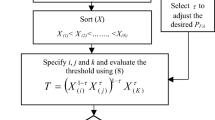Abstract
In this paper, we propose to analyze the binary integration of the cell-averaging constant false-alarm rate (CA-CFAR) and order statistics constant false-alarm rate (OS-CFAR) detectors in the presence of non-Gaussian spiky clutter modeled as a Pearson distribution. We derive new closed form expressions for false alarm and detection probabilities for the CA-CFAR detector in the presence of Pearson-distributed clutter backgrounds. We first show that the use of binary integration improves the detection probabilities of the detectors considered. Secondly, the maximum of detection probability occurs for an optimum choice when the second threshold is set to be equal to M = (3/4) L. For this optimum M-out-of-L rule, the comparison analysis of the CA-CFAR and OS-CFAR binary integrators showed that the latter has better performance in homogeneous Pearson- distributed clutter.
Similar content being viewed by others
Explore related subjects
Discover the latest articles and news from researchers in related subjects, suggested using machine learning.References
Finn H.M., Johnson R.S.: Adaptive detection mode with threshold control as function of spatially sampled clutter level estimates. RCA Rev. 29, 414–463 (1968)
Weiner M.A.: Binary integration of fluctuating targets. IEEE Trans. Aerosp. Electron. Syst. 27(1), 11–17 (1991)
Himonas S.D.: CFAR integration processors in randomly arriving impulse interference. IEEE Trans. Aerosp. Electron. Syst. 30(3), 809–817 (1994)
Schleher D.C.: Radar detection in Weibull clutter. IEEE Trans. Aerosp. Electron. Syst. 12(6), 736–743 (1976)
Goldstein G.B.: False alarm regulation in log-normal and weibull clutter. IEEE Trans. Aerosp. Electron. Syst. 9(1), 84–92 (1973)
Ward K.D.: Compound representation of high resolution sea clutter. Electron. Lett. 17, 561–563 (1981)
Watts S.: Radar detection prediction in sea clutter using the compound K-distribution model. IEE Proc., Part F 132, 613–620 (1985)
Pierce, R.D.: RCS characterisation using the alpha-stable distribution. In: Proceedings of the IEEE national Radar Conference, pp. 154–159 (1996)
Pierce, R. D.: Application of the positive alpha-stable distribution. In: IEEE Signal Processing Workshop on Higher-Order Statistics, pp. 420–424. Banff, Alberta, Canada (1997)
Tsakalides P., Trinci F., Nikias C.L.: Performance assessment of CFAR processors in Pearson-distributed clutter. IEEE Trans. Aerosp. Electron. Syst. 36(4), 1377–1386 (2000)
Kuruoglu, E.E.: Analytical representation for positive alpha stable densities. In: Proceedings of the IEEE International Conference in Acoustics, Speech and Signal Processing, vol. 6, pp. 729–773 (2003)
Rohling H.: Radar CFAR thresholding in clutter and multiple target situations. IEEE Trans. Aerosp. Electron. Syst. 19(4), 608–621 (1983)
Papoulis A.: Probability, Random Variables and Stochastic Processes. McGraw-Hill, New York (1984)
Prudnikov A.P., Brychkov Y.A., Marichev O.I.: Integrals and Series, Volume 1: Elementary Functions. Gordon and Breach science publishers, New York (1986)
Author information
Authors and Affiliations
Corresponding author
Rights and permissions
About this article
Cite this article
Meziani, H.A., Soltani, F. Optimum second threshold for the CFAR binary integrator in Pearson-distributed clutter. SIViP 6, 223–230 (2012). https://doi.org/10.1007/s11760-010-0207-3
Received:
Revised:
Accepted:
Published:
Issue Date:
DOI: https://doi.org/10.1007/s11760-010-0207-3




